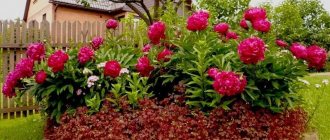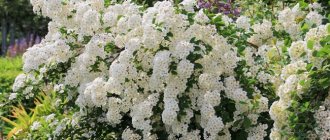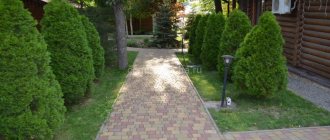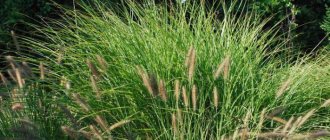Irises (also known as cockerels or irises) are distinguished by their unusual beauty. They have all kinds of shapes, sizes, shades. These flowers look great in single or mixed plantings. They get along well with almost all plants, making garden plots bright and colorful.
A flower garden with irises can be found in almost every garden. Since it is distinguished by an abundance of colors, long flowering and ease of care.
The most beautiful types of irises
In total there are more than 800 varieties of irises. They come in single-color, two-color or iridescent. Some varieties reach a height of more than 0.7 m, others less than 0.4 m. All species have different petal densities from translucent to waxy, and bud shapes (corrugated, wavy, with patterns, bright inclusions).
All irises are divided into groups:
- Bearded . They are distinguished by the presence of hairs on the inside of the buds. The hairs are especially clearly visible on the bends of the plate, which resemble a beard sticking out downwards. These varieties are more drought-resistant and completely unpretentious in care. The best varieties of this species are Cloud Ballet (a romantic light blue flower), Depehe Mode (distinguished by its original color - soft yellow with a purple pattern).
- Beardless . They are not as graceful and are characterized by yellow spots on the buds. It is better to plant beardless irises near water bodies in the country. Since they really like high moisture.
- Dwarf . They are distinguished by their small height (no more than 40 cm). Some varieties even reach a height of only 20 cm. Dwarf irises on the site are suitable for decorating compact flower beds. The most popular varieties are: Wink (a snow-white flower with blue petals around the edge), Cry Baby (blooms in blue, which later becomes almost white).
- Bulbous . Unlike other varieties, they grow from bulbs. They are distinguished by early flowering, as soon as the first snow melts. They are divided into three types: reticulated iris (its height is 15 cm), Juno (the rarest variety), and Dutch iris (the most capricious and demanding to care for). Bulbous species combine harmoniously with crocuses, snowdrops, and muscari.
- Siberian . They have unusually beautiful flowers and brightly saturated leaves. The best varieties: Ester CDM (snow-white flower), Clarkei (pale purple flowers).
- Swamp . Most often found in the wild near water bodies. Their height can reach 2 m. They love shade, so in garden plots they are planted along fences or under trees. The best varieties are: Veriegata (small flowers of pale blue color), Flore Plena (have double yellow buds).
- Japanese . They are shaped like orchids. They are low, from 15 to 25 cm. Popular varieties are: the ghost of happiness (a white flower with pink streaks, consisting of 6 petals), Vasily Alferov (a giant flower, more than 1 m high, with large dark purple flowers).
Attention: the height of bearded irises can reach 0.8 m. Therefore, they should not be planted next to low plants.
Planting rhizomes
Large bulbs or rhizomes are chosen for planting; they contain a large amount of nutrients that can help develop into a full-fledged plant.
Planting irises involves creating small holes, 4-5 centimeters deep. The distance between the future inhabitants of the flowerbed is made from 10 to 50 centimeters, depending on the height of the future inhabitant of the flowerbed.
In addition, it should be taken into account that rhizomes can multiply quickly. From one plant in the future you will get a whole meadow of charming flowers.
How to use irises in garden decoration
Irises in landscape design are used both as mono plantings and in various flower arrangements. Almost all of them are distinguished by heterogeneous colors. Their petals necessarily contain inclusions of other colors, stains, and ornaments. They emphasize all the charm and contrast of the plant.
Attention : if there is a pond in the garden, this is an ideal place for planting cockerels.
When thinking about how to plant irises beautifully, you should take into account the varieties of irises and their requirements for care:
- Dwarf species are planted in rockeries or alpine hills. Dark purple, burgundy, and brown colors will look great against the background of light stones. Yellow or blue iris should be planted near juniper;
- It is also customary to plant low varieties of irises of various colors along paths and alleys;
- swamp varieties are shade-loving, and therefore are planted under trees or next to bushes;
- modular plantings in the form of a rectangle or square can emphasize the originality of the garden. They can be made from different types and varieties of killer whales.
Attention : when planting two-color irises, a single-color background is selected.
Care
To obtain a beautiful blooming iris, planting and care must be competent. In this case, no special effort is required; even a young florist can cope with the task.
If the planting material was purchased in a store or stored at home, it must be treated with growth stimulants before planting.
Long roots are shortened and rot is removed. For disinfection, the material is kept in a manganese solution for 20 minutes.
In order for flowers to please gardeners for as long as possible, it is enough to water them in a timely manner and loosen the soil, no deeper than 2 cm.
To keep the moisture longer, you can add mulch to the soil, in the form of peat or fallen pine needles.
It is equally important to maintain a distance of 50 cm between plants. The photo of irises shows what can ultimately be achieved with the right approach.
Iris flower beds: flower beds, iridariums, modules
Irises in the landscape are distinguished by their sophisticated appearance, interesting shapes, and variety of shades. These plants are used quite often by designers. Tall varieties are usually planted in the background next to emerald thujas and junipers. They will also look beautiful against the background of barberry.
What do irises go with in a flowerbed?
Many gardeners wonder: what to plant irises with? These plants look harmonious and get along well with almost all flowers. They can be planted next to herbaceous plants: phlox, hosta, bergenia.
How to beautifully plant irises in the garden
A flower bed with irises will look beautiful in any corner of the garden. Typically, designers make bright accents on these plants, planting them in the central part of the flower garden, along alleys and paths, near ponds.
Iris of different colors, planted in the same flower bed, look very beautiful. Landscape design experts recommend planting cockerels asymmetrically, making the boundaries unclear and blurred. For example, an alley of irises planted in a checkerboard pattern will look stylish and unusual.
Another use of universal trios for flower beds
Combinations of plants, with which you can create the simplest of flower beds, are a universal combination of plants that “works” not only in individual compositions. If you suddenly need to quickly “patch holes” in large flower beds or flower beds, a bald spot suddenly appears between your favorite plants, then you can easily close it using one of three plants in combination. It’s enough to look at your neighbors and you’ll find the masker himself. So, between phloxes and delphiniums a bush of one of the hybrid varieties of helenium can easily fill the void, and between poppies and irises you can plant geranium.
Flowerbeds of irises with roses, peonies, daylilies
When considering what irises are combined with in a flowerbed, it is worth considering such options as: peonies, roses, lilies. For example, cockerels will quietly hide the bare stems of roses, making them more graceful and elegant. And the alternation of white peonies and bright cockerels will make the garden unique and romantic.
Is it possible to plant irises of different varieties together?
Irises can be planted in a flowerbed of different varieties: dwarf, bearded, Japanese, Siberian. Thus, you will be able to create a beautiful and aesthetic flower bed. Just when thinking about how to stylishly decorate a flowerbed at home with irises, you should consider the following:
- pale colors will be lost against the background of bright ones;
- two-color varieties against a plain background will look more impressive;
- dark buds combine beautifully with other types of dark colors.
A flower bed of irises of different colors will also look original. Such a colorful and cheerful composition will become a real decoration of the garden. In this case, you should use the following scheme:
- dwarf varieties are planted as a border or along the edges of a flower garden;
- medium-sized species are planted behind them;
- The tallest flowers are placed in the center.
Attention: when creating a flower bed from different varieties of cockerels, it is important to take into account their flowering period. It is advisable to select varieties in such a way that as some plants fade, the next ones will immediately bloom. Then on your site you will get an incomparable flowerbed of continuous flowering from only cockerels.
In conclusion, it is worth noting that irises are in great demand in landscape design. They are planted on the lawn, near recreation areas, and by the pond. The main thing when creating colorful flower beds with killer whales is to take into account their color palette. You should not plant other too bright and variegated plants nearby, as they will simply merge into one spot.
Irises in the landscape design of a summer cottage are completely unpretentious to care for. The main thing for them is to choose a sunny place (but so that the plants are not exposed to direct sunlight), take care of good watering, and not plant plants nearby that will clog and oppress them.
How to plant and care for plants
These plants need to be planted where it is warm and there is light for most of the growing season.
The soil should be rich in organic matter and minerals.
These perennials need to be planted from mid-August to the end of September. In the time before the first frost, the seedlings must have time to restore the root system and gain enough nutrients for wintering. This means that after planting, young shoots should grow, providing the roots with the necessary supply.
During the first year, a young bush needs to be looked after especially carefully. During periods of insufficient moisture, it is necessary to water with warm water. At least twice a season you need to fertilize.
After your bush begins to actively bloom, caring activities should be expanded by plucking out the buds. The fact is that the bush spends a lot of energy on flowering. If you remove all the buds in the first year, the bush will direct all its energy to vegetative propagation and the formation of new shoots. As a result, in the second year you will no longer receive a single weak flower, but a whole cap of large and beautiful flowers.
Since peonies are planted for a long time, you need to carefully prepare the planting site. First, prepare the bed or flowerbed itself. It is best to carry out the following activities.
- 1Determine the size of the area that should be completely filled with peony bushes.
- 2Dig a hole 20-30 cm deep in place of this area. Place the soil nearby.
- 3 Place a layer of manure or humus about ten centimeters thick on the bottom of the hole.
- 4 Place grass, hay, sawdust or peat on this layer. Cover it all with the soil that was removed during the digging of the hole.
All these procedures are preparatory in nature, so they need to be carried out in advance - in the spring, or better yet, in the fall. During this time, manure and grass will begin to rot, and the soil will be enriched with nitrates, which are so necessary for the young sprout to ensure growth in the early period.
Such formation of a base for a flowerbed will allow you to forget about problems with organic fertilizers for 5 years. All that remains is to occasionally feed with special mineral fertilizers to stimulate abundant flowering.
Since peonies love loose soil rich in organic matter, they need to be covered with dry grass on top for the winter. It will not only protect the wintering parts from sudden temperature changes, but will also ensure the flow of organic matter into the soil without digging up the soil. However, dry grass can introduce weed seeds, so try to use only leaves or shoots without seeds for this purpose.











